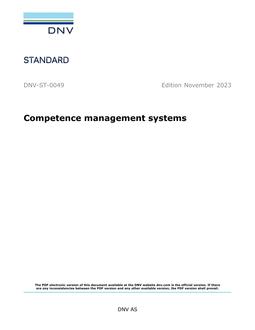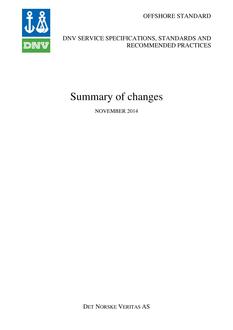-
-
Available Formats
- Availability
- Priced From ( in USD )
-
Available Formats
-
- Secure PDF 🔒
- Immediate download
- $57.00
- Add to Cart
-
- Printed Edition
- Ships in 1-2 business days
- $57.00
- Add to Cart
Customers Who Bought This Also Bought
-

DNV DNV-ST-0049
Priced From $57.00 -

DNV DNV-RU-SHIPS PART 7 CHAPTER 1
Priced From $57.00 -

DNV DNV-OS-J103
Priced From $57.00 -

DNV DNV SUMMARY OF CHANGES
Priced From $57.00
About This Item
Full Description
This "Recommended Practice" (RP) has been prepared to facilitate the work of pipeline operators, general contractors as well as sub-contractors carrying out coating work. While the requirements and recommendations are general, the document contains advice on how amendments can be made to include project specific requirements, and requirements and/or guidelines by a regulating authority, or to reflect the pipeline operator's general philosophy on pipeline corrosion control.
This RP covers the process of applying specific types of FJC / CFR and ‘infill' systems. The conceptual and detailed design of such systems (i.e. for the purpose of corrosion and/or mechanical protection and thermal insulation), and the verification of such design by special testing, are not covered.
Guidance note:
Pipeline operators and main contractors should consider the needs to carry out qualification of generic coating systems for specially demanding applications; e.g. resistance to bending during installation by reeling and long term (>10,000 hrs) thermal degradation of critical coating properties associated with high operating temperatures. Purchasers of linepipe coating should further consider pre-qualification of coating manufacturers prior to the issue of purchase documents.
The following 9 categories of FJC / CFR systems, applicable to corrosion control of submarine pipelines, and including associated risers, are covered in this document (see ANNEX 1):
— 1A Adhesive tape (PVC or PE backing), with typical thickness of about 2 mm and mastic type adhesive, applied on substrate mechanically treated to Sa 2½ or St 3 (FJC only).
— 1B Heat shrink sleeve (PE backing) with mastic type adhesive applied on substrate mechanically treated to Sa 2½ or St 3 (FJC only).
— 2A PE heat shrink sleeve or repair patch (thickness 2-3 mm) with modified PE adhesive, applied on top of LE layer (min. 100 mm). Steel substrate treated by blast cleaning to Sa 2½ .
— 2B As for 2A, but with heat shrink sleeve or repair patch in PP.
— 3A FBE layer (min. 350 mm). Steel substrate treated to Sa 2½. LE (min. 100 mm) for repairs.
— 3B As for 3A (lower FBE thickness may apply), with PE heat shrink sleeve (2-3 mm) applied on top and an intermediate layer of PE adhesive. (FJC only).
— 3C As for 3A (lower FBE thickness may apply), with PP heat shrink sleeve (2-3 mm) applied on top. Fused bonding of PP to PP parent coating.
— 3D As for 3A (lower FBE thickness may apply), with PP (3mm) applied by flame spraying, wrapping or extrusion (e.g. injection moulding). Fused bonding of PP to PP parent coating.
— 4A Polychloroprene sleeve, wrapping or patch (on top of primer) with vulcanised bonding to parent coating. Steel substrate treated by blast cleaning to Sa 2½ ( Used for linepipe coating in the same material type and typically applied by the same contractor).
For concrete coated pipes and thermally insulated pipes, the FJC systems above may be used in combination with a moulding infill. The following 4 types of infill are covered (see ANNEX 2):
i) asphalt mastic
ii) polyurethane
iii) rapid setting concrete
iv) polypropylene.
I and II may be applied directly on the field joint (FJ) with or without a primer coat (bonding agent). I, II and III are applicable for pipelines with concrete coating whilst II an IV are used for PP multilayer coatings for thermal insulation, typically with an inner 3-layer PP coating. II and IV may be applied as a homogenous solid product, sometimes with a filler material added, or as a foamed product. The manufacturing of half shells (typically on PU or PP basis) to be strapped around a FJ (with or without a FJC system) is not covered by this RP.
This RP may be fully or partly applicable to similar coating and infill systems, or to FJC / CFR associated with onshore pipelines. The user shall consider the needs for amendments and deviations for such applications.
The following activities associated with FJC / CFR are not covered:
— Requirements for the qualification of supplier specific coating materials for general (i.e. not project specific) purposes (see Guidance Note to 1.2.2).
— Detailed design of FJC for project specific purposes (e.g. heat insulation, see 1.2.2).
— Inspection of linepipe coating during installation and characterisation of damage for subsequent CFR. (In case of minor coating damage; i.e. where the inner corrosion protective coating is not affected, the requirements to CFR in this document may not be relevant).
— Repair of concrete weight coating.
Although considerations of safety and environmental hazards associated with coating work and properties of as-applied coating materials (i.e. as reflected by national and multi-national regulations) are of great importance, such are never-the-less beyond the scope of this RP.
Document History
-
DNV DNV-RP-F102
Pipeline field joint coating and field repair of linepipe coating- Most Recent
-
DNV DNVGL-RP-F102
Pipeline field joint coating and field repair of linepipe coating- Historical Version
-
DNV DNV-RP-F102
PIPELINE FIELD JOINT COATING AND FIELD REPAIR OF LINEPIPE COATING- Historical Version
-
DNV DNV-RP-F102
currently
viewing
PIPELINE FIELD JOINT COATING AND FIELD REPAIR OF LINEPIPE COATING- Historical Version
-
DNV DNV-RP-F102
PIPELINE FIELD JOINT COATING AND FIELD REPAIR OF LINEPIPE COATING- Historical Version
-
DNV DNV-RP-F102
PIPELINE FIELD JOINT COATING AND FIELD REPAIR OF LINEPIPE COATING- Historical Version





